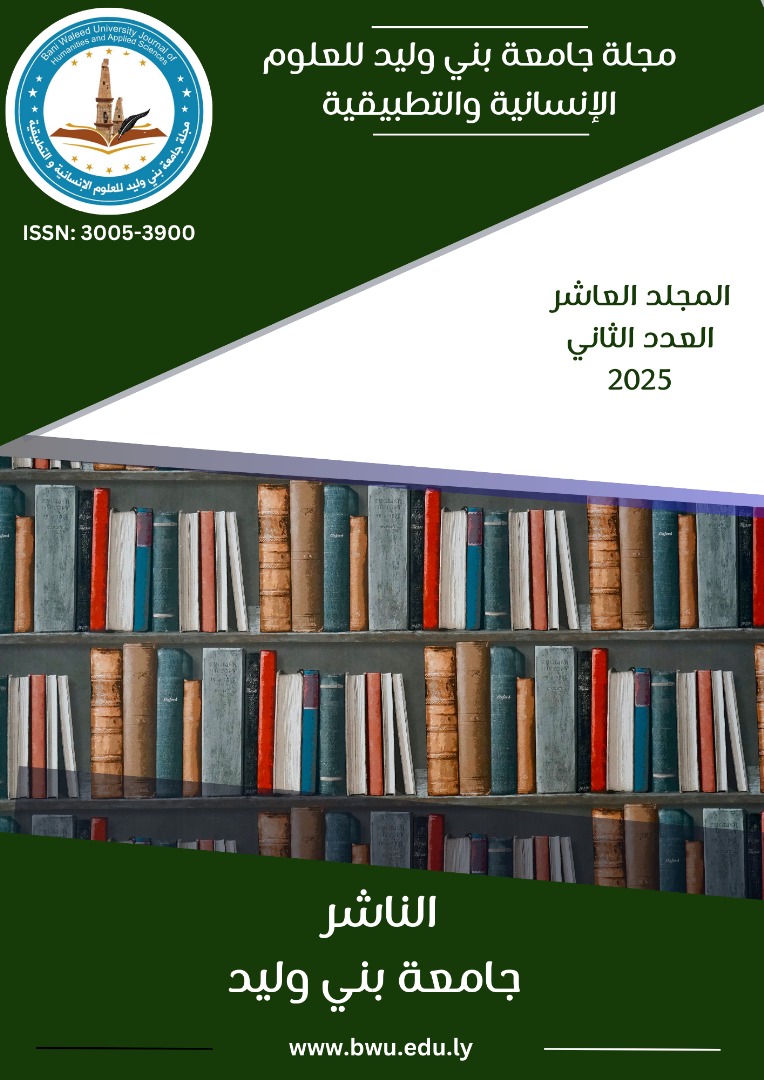Investigating the Impact of Blended Learning on EFL Libyan Students’ Writing Skills at Derna University
DOI:
https://doi.org/10.58916/jhas.v10i2.770الكلمات المفتاحية:
التعليم المدمج – الجامعة، طلاب اللغة الإنجليزية كلغة اجنبية، مهارة الكتابةالملخص
The study aims to investigate the impact of blended learning on EFL Libyan students’ on improvement writing skills. The study conducted with 80 first English language students at Derna university. The study design is experimental approach. The experimental group participated in blended learning while traditional group followed curriculum without utilizing online instruction. Pre- test and post-test conducted in the study to measure students improvement. Analyzing of data use SPSS .The study result showed that there a significant impact of blended learning on students’ improvement writing skills. Recommended for future studies replicate with a larger number of students across different institutions
التنزيلات
المراجع
Alqahtani, A. Y., & Rajkhan, A. A. (2020). E-learning critical success factors during the covid-19 pandemic: A comprehensive analysis of e-learning managerial perspectives. Education sciences, 10(9), 216.
Alsalhi, N. R., Eltahir, M. E., & Al-Qatawneh, S. S. (2019). The effect of blended learning on the achievement of ninth grade students in science and their attitudes towards its use. Heliyon, 5(9).
Alias, N. A., & Zainuddin, A. M. (2005). Innovation for better teaching and learning: Adopting the learning management system. Malaysian online journal of instructional technology, 2(2), 27-40.
Abukhattala, I. (2016). The use of technology in language classrooms in Libya. International Journal of Social Science and Humanity, 6(4), 262-267.
Annamalai N. "How Malaysian lecturers view Mooc and its challenges." J. Nusan. St. (JONUS), vol. 4, no. 2, pp. 144-167, 2019.
Abdulhadi Masoud Aljadi. (2025). The Impact of Educational Materials on Student Motivation in Reading Lessons: A Case Study in Libyan Schools . مجلة جامعة بني وليد للعلوم الإنسانية والتطبيقية, 10(1), 526-537. https://doi.org/10.58916/jhas.v10i1.714
Andreeva N. and Ostroverkhaya, I.V. "Learning to learn with blended learning." Eur. Sci. J., vol. 12, no. 1, pp. 193-203, 2017
Alias N. A. and Zainuddin A. M. “ Innovation for Better Teaching and Learning: Adopting the Learning Management System. |”Mal. Onl. J. Instruc. Tech., vol. 2, no. 2, pp. 27-40, 2005.
Ahmadpour, and Khaasteh, . "Writing behaviors and critical thinking styles: The case of blended learning." Khazar J. Hum and Soc. Sci., vol. 20, no. 1, pp. 5-24, 2017.
Bersin, J. (2004). The blended learning book: Best practices, proven methodologies, and lessons learned. New York, NY: John Wiley & Sons.
Chew, E., Jones, N., & Turner, D. (2008). Critical review of the blended learning models based on Maslow’s and Vygotsky’s educational theory. In Hybrid Learning and Education: First International Conference, ICHL 2008 Hong Kong, China, August 13-15, 2008 Proceedings 1 (pp. 40-53). Springer Berlin Heidelberg.
Darus, S. and Subramaniam,K.. "Error analysis of the written English essays of secondary school students in Malaysia: A case study." Eur. J. Soc. Sci., vol. 8, no. 3, pp. 483-495, 2009.
Dwivedi, R.S and Chakravarthy, R.V. Problems encountered by rural students in writing English: role of English teacher-some solutions. Int. J. Stu. Eng. Lang. Lit., vo. 3, no. 7, pp. 27-38, 2015.
Emelyanova, N. and Voronina, E. "Introducing blended learning in the English language classroom: Students’ attitudes and perceptions before and after the course." Kno. Man. & E-Learn., vol. 9, no. 1, pp. 33-49, 2017.
Feldstein, M., & Hill, P.(2016). Personalized Learning: What It Really Is and Why It Really Matters. EDUCAUSE Review.
Gecer, A., & Dag, F. (2012). A blended learning experience. Educational Sciences: Theory and Practice, 12(1), 438-442
Geta, M., & Olango, M. (2016). The impact of blended learning in developing students’ writing skills: Hawassa University in focus. African Educational Research Journal, 4(2), 49-68.
Garrison, D. R., Anderson, T., & Archer, W. (2001). Critical thinking, cognitive presence, and computer conferencing in distance education. American Journal of distance education, 15(1), 7-23.
Graham, C. R. (2006). Blended learning systems: Definition, current trends, and future directions . In Bonk, C. J., & Graham, C. R. (Eds.), Handbook of blended learning: Global perspectives, local designs. San Francisco, CA: Pfeiffer.
Horn, M. B., & Staker, H. (2017). Blended: Using disruptive innovation to improve schools. John Wiley & Sons.
Jumariati, J., & Febriyanti, E. R. (2020). LINE application: An alternative tool to develop writing abilities. Journal on English as a Foreign Language, 10(1), 68-83.
Khader, N. S. K. (2016). The Effectiveness of Blended Learning in Improving Students' Achievement in Third Grade's Science in Bani Kenana. Journal of Education and Practice, 7(35), 109-116
Liu M. "Blended learning in a university EFL writing course: Description and evaluation." J. of Lang. Teach. Res., vol. 4, no. 2, pp. 301-309, 2013.
Lanham, E., Augar, N., & Zhou, W. (2005). Creating a blended learning model for cross-cultural e-learning: Putting theory into practice. In Proceedings of the World Conference on E-Learning in Corporate, Government, Healthcare, and Higher Education (pp. 2623-2630)
Moiseienko, N. V., & Ozarko, I. I. (2019). Types of blended learning. Science and education a new dimension. Pedagogy Psychol, 76(187), 47-50.
Mabuan,R. and Ebron J.G.. "A blended learning approach to teaching writing: Using E-mail in the ESL classroom." Asian EFL J., vol. 4, no. 1, pp. 80-103, 2017.
Mamo, F. (2021). The Effect of Blended Approach in Enhancing Students Writing Skills. Language Education Forum, 2(1), 7-14
Nurdin, K., Sulfasyah, S., & Madeamin, R. (2023). The Effect of Applying Blended Learning Using Interactive Writing on Learning Interest and Indonesian Writing Skills in Writing. Edunesia : Jurnal Ilmiah Pendidikan, 4(3), 1501–1514.
Odabasi, H. F. (2000). Faculty use of technological resources in Turkey. Innovations in Education and Training International, 37(2), 103-107.
Pane, J. F., Steiner, E. D., Baird, M. D., Hamilton, L. S., & Pane, J. D. (2017). Informing progress. Seattle, WA: RAND.
Rao, P. S. (2019). The significance of writing skills in ell environment. ACADEMICIA: An International Multidisciplinary Research Journal, 9(3), 5-17.
Stein, J., & Graham, C. R. (2014). Essentials for blended learning: A standards-based guide. Routledge.
Saleh, N., & Khader, K. (2016). The Effectiveness of Blended Learning in Improving Students’ Achievement in Third Grade’s Science in Bani Kenana. The Effectiveness of Blended Learning in Improving Students’ Achievement in Third Grade’s Science in Bani Kenana, 7(35). https://files.eric.ed.gov/fulltext/EJ1126508.pd.
Shohel, M. M. C., Ashrafuzzaman, M., Azim, F., Naomee, I., Rahman, M. S., & Siddik, M. A. B. (2022). Blended Learning Space for Primary and Secondary Education: Challenges and Opportunities in Resource-Constrained Contexts. In Designing Effective Distance and Blended Learning Environments in K-12 (pp. 187-222). IGI Global. https://doi.org/10.4018/978-1-7998-6829-3.ch012
Wang, Y., Han, X., & Yang, J. (2015). Revisiting the Blended Learning Literature: Using a Complex Adaptive Systems Framework. Educational Technology & Society, 18 (2), 380–393








